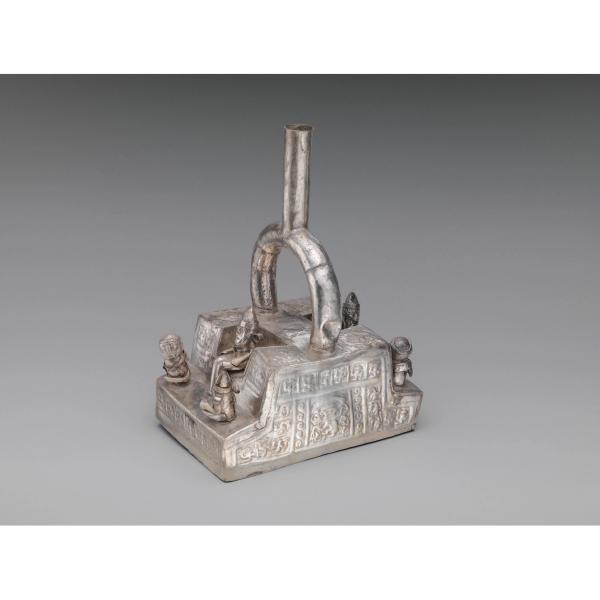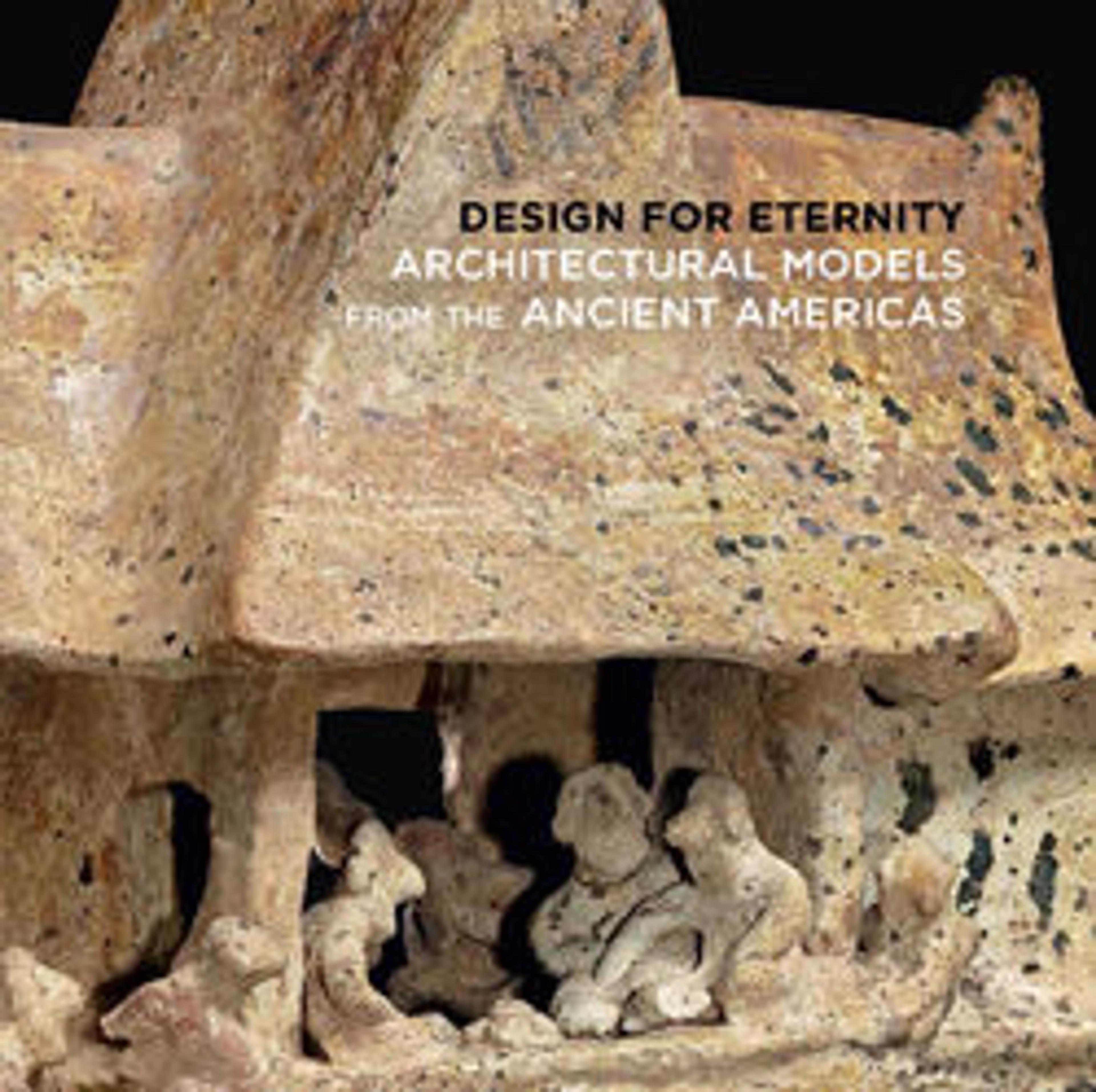Stirrup-spout bottle with palace scene
This bottle, made of pieces of silver sheet that were cut, embossed, and soldered together to create a vessel with a body in the shape of an architectural platform with figures, may have been meant to evoke an area within the Chan Chan palaces. A central figure with a conical headdress and large ear ornaments is shown seated within a niche-like space, flanked by two figures seated in front of him, one wearing a similar conical headdress and ear ornaments, and the other bearing what may be a sack over his shoulders. The scene is repeated on the opposite side of the vessel. The walls of the structure are decorated in the style of the Chan Chan palaces and other nearby structures such as Huaca el Dragón, with reliefs depicting figures with crescent headdresses and marine birds. The principal individuals are seated on throne-like audiencias—U-shaped structures that were often located adjacent to storage facilities. Whether the figures with sacks over their shoulders were intended to represent long-distance traders or bringers of tribute is unknown, but surely the scenes speak to some sort of interchange within the walls of this wealthy city.
Between the twelfth and fifteenth centuries, the Chimú kingdom dominated some 800 miles of Peru’s North Coast, from just south of the modern border with Ecuador to just north of Lima. The remains of Chan Chan, at the edge of the Pacific Ocean, encompasses some 8 square miles (20 km2). The royal compounds had high perimeter walls, grand open courtyards, walk-in wells, and ample storage facilities. These palaces had a single entrance, on the north perimeter wall, and progress through the palaces was impeded by a system of baffled entries, further restricting the flow of visitors into the compounds’ interiors. Sixteenth-century accounts of the looting of these palaces describe the immense quantities of riches they once held, including dozens of vessels of silver and gold. Few such works have survived to the present day, particularly works in silver—a metal that does not survive well in the archaeological record as it can deteriorate when exposed to salts and other minerals in the soil when buried. A rare survival of Chimú silverwork, this bottle speaks to a tradition for which the Chimú were once famed. That fame is reflected in the fact that shortly after the Chimú were conquered by the Incas, the silversmiths of Chan Chan were taken to Cusco, the Inca capital, where they were pressed into service of the newly dominant Inca Empire.
Joanne Pillsbury, Andrall E. Pearson Curator, Arts of the Ancient Americas, 2018
References and Further Reading
King, Heidi, Luis Jaime Castillo Butters, and Paloma Carcedo de Mufarech. Rain of the Moon: Silver in Ancient Peru. New York: The Metropolitan Museum of Art; New Haven, Conn.: Yale University Press, 2000.
Pillsbury, Joanne. “Imperial Radiance: Luxury Arts of the Incas and their Predecessors,” in Golden Kingdoms: Luxury Arts in the Ancient Americas, edited by Joanne Pillsbury, Timothy F. Potts, and Kim Richter, pp. 33-43. Los Angeles: The J. Paul Getty Museum, 2017.
Pillsbury, Joanne. “Reading Art without Writing: Interpreting Chimú Architectural Sculpture,” in Dialogues in Art History, from Mesopotamian to Modern: Readings for a New Century, Elizabeth Cropper, ed., pp. 72-89. Studies in the History of Art 74, Center for Advanced Study in the Visual Arts Symposium Papers LI. Washington D.C.: National Gallery of Art, Distributed by Yale University Press, 2009.
Pillsbury, Joanne, Patricia Sarro, James Doyle, and Juliet Wiersema. Design for Eternity: Architectural Models from the Ancient Americas. New York: The Metropolitan Museum of Art, 2015.
Artwork Details
- Title:Stirrup-spout bottle with palace scene
- Artist:Chimú artist(s)
- Date:1000–1470 CE
- Geography:Peru, North Coast
- Culture:Chimú
- Medium:Silver
- Dimensions:H. 9 1/4 x W. 4 3/8 x D. 6 1/2 in. (23.5 x 11.1 x 16.5 cm)
- Classification:Metal-Containers
- Credit Line:The Michael C. Rockefeller Memorial Collection, Gift of Nelson A. Rockefeller, 1969
- Object Number:1978.412.170
- Curatorial Department: The Michael C. Rockefeller Wing
Audio

1648. Stirrup-spout bottle with palace scene, Chimú artist(s)
Joanne Pillsbury
JOANNE PILLSBURY: The palace was the locus of this crucial exchange of very high-level, elite goods like textiles, works of art in gold and silver and shell. And so, what we see on this vessel is a dignitary seated in a niche. He’s wearing a conical headdress, and he is seated apparently speaking with two other figures, and that’s repeated on the other side as well.
I am Joanne Pillsbury. I’m a curator of the arts of the ancient Americas at the Metropolitan Museum of Art.
JOSÉ MARÍA YAZPIK (NARRATOR): The form of this bottle—its stirrup-shaped handle and spout—connect it to an ancient tradition, while the design connects it to the city of Chan Chan.
JOANNE PILLSBURY: What we see on the sides of the vessel shows a great deal of similarity with the architectural sculpture from the palaces at Chan Chan. So we see the same types of imagery, these bands of seabirds, these wave-like motifs… This is the sort of imagery that Chimú artists would render in adobe relief on the interior walls of the palaces at Chan Chan.
JOSÉ MARÍA YAZPIK: Chan Chan, founded around 1000 CE, was the imperial capital of the Chimú.
JOANNE PILLSBURY: It was a city that was filled with artists. We think that perhaps as much as a third of the members of the population of the city were engaged in craft production of some sort or another. Chan Chan was famed for the quality of its metalwork.
JOSÉ MARÍA YAZPIK: The success and fame of these artists might have been Chan Chan’s undoing. The Inca attacked and plundered the city.
JOANNE PILLSBURY: When the Inca conquered Chan Chan, they took the metalworkers captive. They were kidnapped, and they were taken to Cuzco, to the Inca capital and pressed into service high in the Andes, in the service of the expanding Inca Empire. It reminds us that in the ancient Americas, artists were of such importance that they themselves could become spoils of war.
More Artwork
Research Resources
The Met provides unparalleled resources for research and welcomes an international community of students and scholars. The Met's Open Access API is where creators and researchers can connect to the The Met collection. Open Access data and public domain images are available for unrestricted commercial and noncommercial use without permission or fee.
To request images under copyright and other restrictions, please use this Image Request form.
Feedback
We continue to research and examine historical and cultural context for objects in The Met collection. If you have comments or questions about this object record, please contact us using the form below. The Museum looks forward to receiving your comments.
